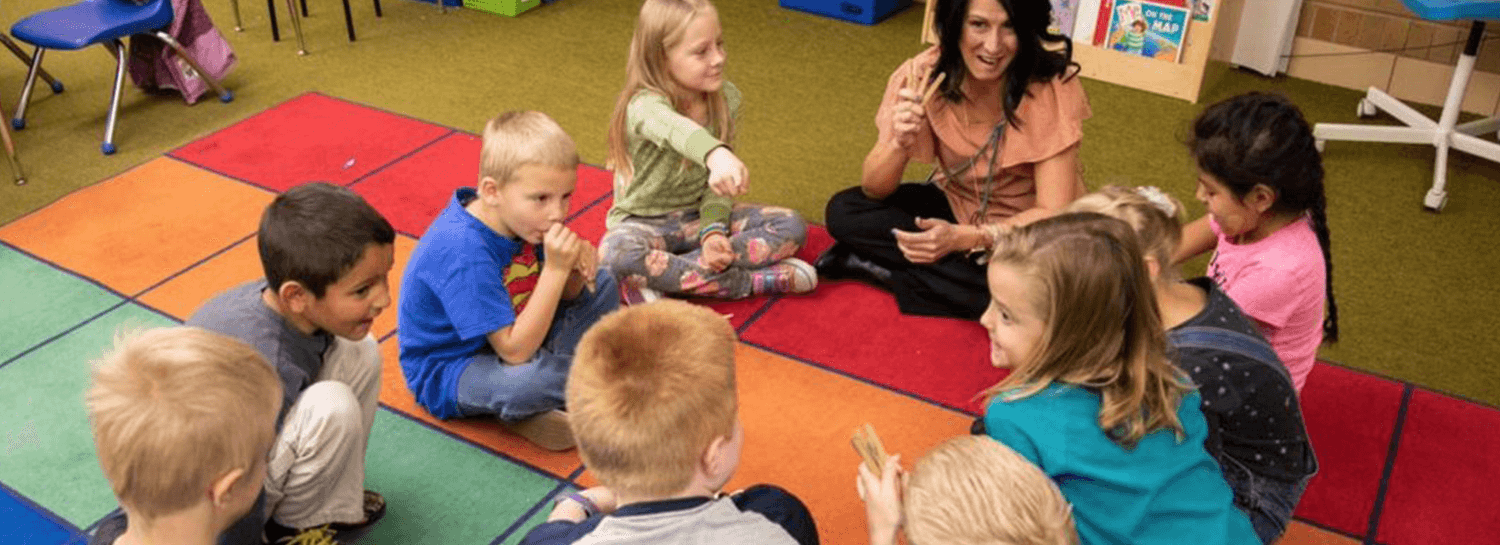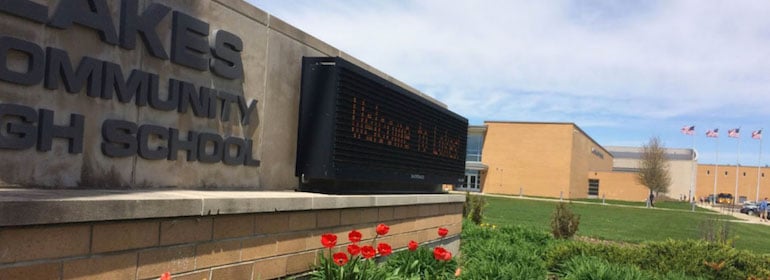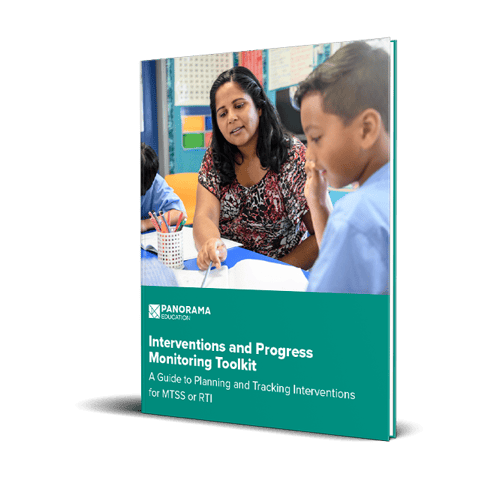Learn how Jordan School District—a district of 63 schools and over 56,000 students—is supported a 2% increase in the graduation rate, 50% fewer F’s, and 61% fewer tips in suicide ideation at one high school.
Challenges
-
Jordan's administrative team was looking for proactive, preventative programs that would help them identify and intervene when students were struggling.
-
However, Jordan's existing student information system was prohibitive and caused challenges for many years. Getting the information they needed out of the system was extremely difficult.
Solution
Results
-
With Panorama, Jordan has a dashboard that they can quickly maneuver through in seconds. This helps educators find the students that need help or that potentially may need help. It is a preventative measure, instead of reactionary.
-
The Student Success dashboard gives administrators a holistic view of students, which helps inform decision making processes.

The mission of Jordan School District is to support students in reaching their potential to achieve academically, prosper economically, and contribute responsibly to society.
Located in West Jordan, Utah, the district is the fourth largest in the state with over 63 schools, five specialty schools, serving over 56,000 students and growing.
With the cost of housing rising in the Salt Lake Valley, Jordan School District has experienced rapid growth (opening a new school almost every year) and changing demographics. Leaders knew that they needed to approach things differently in order to best support a diverse population of students, teachers, and staff. For them, this meant adopting a restorative MTSS (multi-tiered system of supports) approach that provides what students need—the way they need it—while simultaneously focusing on academics and well-being.
We sat down with three members of the Jordan team—Travis Hamblin (Director of Student Services), Stacee Worthen (Secondary Counselor Specialist), and Julie Scherzinger (High School Assistant Principal)—to learn more about their partnership with Panorama. In our conversation, they discussed how Panorama is helping them bring their restorative MTSS to life through quick access to whole-child data in Panorama Student Success.
Check out the highlights below to learn how this strategy resulted in a 2% increase in the graduation rate, 50% fewer F’s, and 61% fewer tips in suicide ideation at one high school in Jordan School District.
A Restorative MTSS With Panorama: Relationship Driven and Data Informed
Travis Hamblin, Director of Student Services: Relationships don’t support the learning, relationships are the learning. That’s why we focus on restorative MTSS and why we use a tool like Panorama to determine how to best help kids. We need data. But it can’t just be data driven; it has to be relationship driven with a learning focus that is data informed. That, to us, is the most critical pathway to getting what all of those in our district need.
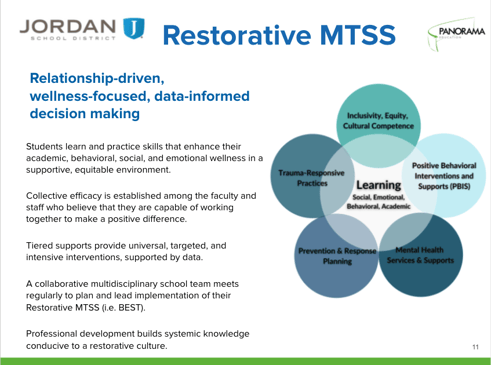
Panorama Student Success has made our data more accessible. As part of implementing a restorative culture throughout our district, we recognized we needed a data dashboard to create a data-centered decision making process. Our existing student information system was prohibitive and caused challenges for many, many years. Getting the information we needed out of our system was extremely difficult.
Now, with Panorama, we have a dashboard that we can quickly maneuver through in seconds. This helps us find the students that we need to help or that potentially may need help. It becomes a preventative measure instead of reactionary.
With Panorama, we’re no longer guessing. We’re asking the right questions to understand how to best help students. Is it that the student feels no connection to school that is precipitating poor attendance, which means they’re not getting great grades? Or maybe they have great grades, but they don’t feel connected to school?
"With Panorama, we’re no longer guessing. We’re asking the right questions to understand how to best help students."
— Travis Hamblin, Director of Student Services
The Impact of Panorama Student Success: 50% Fewer F’s and 2% Increase in the Graduation Rate at Herriman High
Julie Scherzinger, Assistant Principal at Herriman High: In 2017-18, we needed to make some serious changes to our school culture. As an administrative team, we were looking for proactive, preventative programs that would help us identify and intervene when students were struggling. Through our research, we found Panorama. In the last four years and since implementing Panorama, we have 50% fewers F’s and 61% fewer tips in reporting suicide ideation at the school. This is what I love about Panorama: We can focus on both social health and on academics.
We started using Panorama in February 2020. Then, when the pandemic hit in March and everyone went virtual, we used Panorama to reach out to our students, track our students, and make sure our seniors were staying on track for graduation. In that short period of time, we were able to implement some academic interventions that helped us increase our graduation rate by 2%.
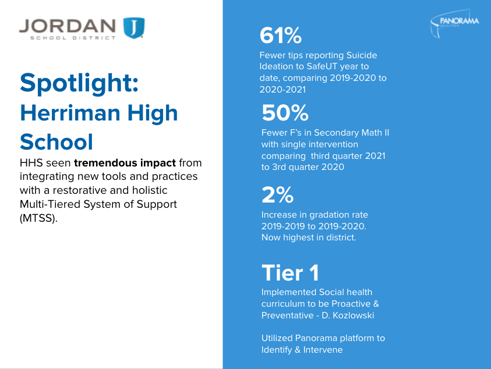
There are two Panorama dashboards that I use often that helped us achieve these results. The first is the Survey dashboard and the second is the Student Success dashboard. I live in these dashboards and use them weekly in our MTSS and RTI meetings because the data give us a more holistic view of the student that helps inform our decisions.
All of this helps us optimize our student support systems. For example, in a matter of three seconds, I can tell you every ELL student in my building, if any are failing, and beyond that I can tell you what grade they’re in, if they have a 504 or IEP, and get any relevant information I need to identify gaps.
"Since implementing Panorama, we have 50% fewer F’s and 61% fewer tips in reporting suicide ideation at the school. This is what I love about Panorama: We can focus on both social health and on academics."
— Julie Scherzinger, Assistant Principal at Herriman High
How Jordan’s Counseling Team Uses Panorama to Target Interventions
Stacee Worthen, Secondary Counselor Specialist: As counselors, it’s important that we use data to drive the decision-making process within our restorative MTSS. We want to work smarter, not harder. Panorama puts the data at our counselors’ fingertips, helps us collaborate with teachers and administrators in one place, and helps us disaggregate our data so we are exposing any barriers to learning.
For example, counselors often help principals figure out who is on the D and F list. Before Panorama, this would take us two days to pull out of our systems and clean up that report. These reports didn’t include anything disaggregated about ethnicity, IEPs, or 504s. With Panorama, we can get this information in a click of a button. This gives counselors more time to work with students rather than trying to find the data that we need.
The even better part is that we get to target our resources. At Jordan, the mental health team and administrators get together to talk about what will work best for each intervention tier. We’re able to ask, what specific Tier 2 interventions can we start using? What programs can we start implementing? It’s exciting that we can be more strategic, targeted, and student driven because we have the information we need at our fingertips with Panorama.
"It’s exciting that we can be more strategic, targeted, and student driven because we have the information we need at our fingertips with Panorama."
— Stacee Worthen, Secondary Counselor Specialist




